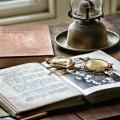This photograph of 1968 was taken by Charles Wardell and shows the impressive Baptist chapel that once stood between Bernfield’s the jeweller and Timothy White’s. Marks and Spencer’s was further up and Hepworth’s the tailor is in the foreground.
This was the second Baptist chapel in Andover, the first built in 1824. At that time, there were just eleven Andover members and all had transferred from nearby Whitchurch where the Baptist connexion had flourished since the 17th century. The 1824 chapel was built on the same site as this later one but would have been a smaller building.
When high streets such as Andover’s were first laid out, they were divided into what was known as burgage plots - long narrow strips of land which allowed a shop front facing the street, with access from a ‘back lane’ that ran behind. In Andover, that was East Street (once called Back Lane), which ran more or less parallel with the High Street. These plots of approximately 20 feet width were largely unchanged for centuries but it was possible for successful shopkeepers to buy the adjacent plot and expand next door.
There was also much activity behind with parts of the land being adapted for other uses, although access to the rear of shops for practical purposes was usually maintained in some form.
By the 1860s the old chapel had become too small for the congregation and it was decided to build again; so, in 1866 it was pulled down and this much grander edifice arose in its place, opening the following year.
A house that lay between the modern Timothy Whites building and the old chapel which belonged to the late James Baker was also demolished to provide the space required. Baker had not lived there but, as a Baptist himself, specifically bought the property to allow for future expansion of the chapel if needed.
His daughter, who then lived in Southampton, insisted on approving the plans before work could go ahead and would only agree if the aim was to provide a new building and not just an extension to the old chapel. It was designed by Searle and Co, who were specialists in chapel architecture but the estimated cost of £1,400 increased to over £1,800 by the time the new building was opened. By this time, church membership had increased to over 100.
There will be many stories of the Baptist chapel in its long history between 1866 and 1980 when it was finally demolished and a new chapel built off Charlton Road. One amusing anecdote is the story of bachelor George Willis who was over 50 when he became minister in 1912. Going away on holiday the same year, he wrote back to the chapel to say he had been married whilst away and would be returning to Andover with his bride. The first hymn to be sung on his return was ‘Dear Lord and Father of mankind, forgive our foolish ways’!
A particular feature of the High Street chapel was the so-called rose window that no doubt cost a considerable sum in 1866. Thankfully, when the church was eventually demolished the rose window was saved and incorporated into the new building where it remains to this day.






Comments: Our rules
We want our comments to be a lively and valuable part of our community - a place where readers can debate and engage with the most important local issues. The ability to comment on our stories is a privilege, not a right, however, and that privilege may be withdrawn if it is abused or misused.
Please report any comments that break our rules.
Read the rules hereLast Updated:
Report this comment Cancel